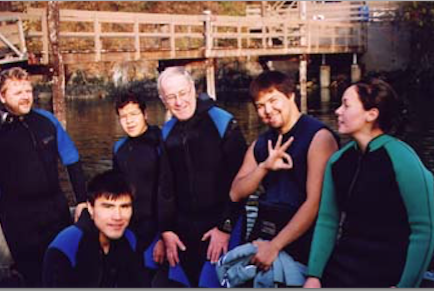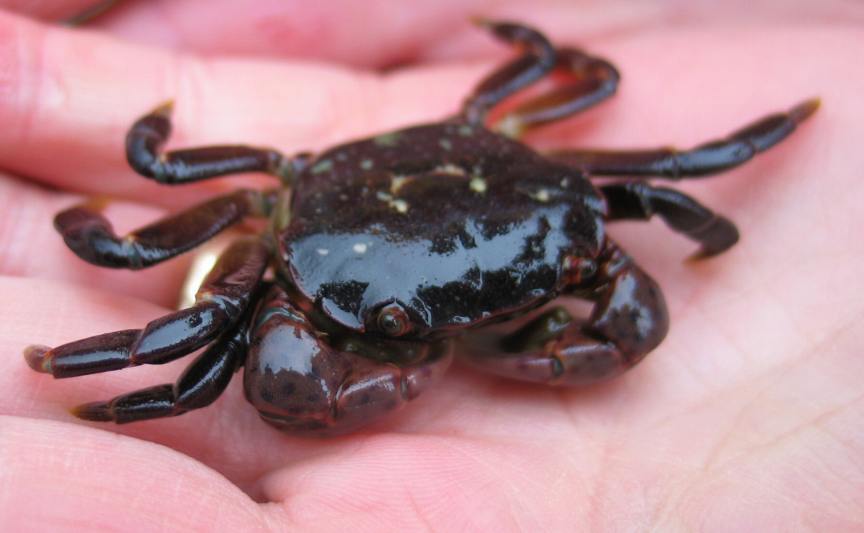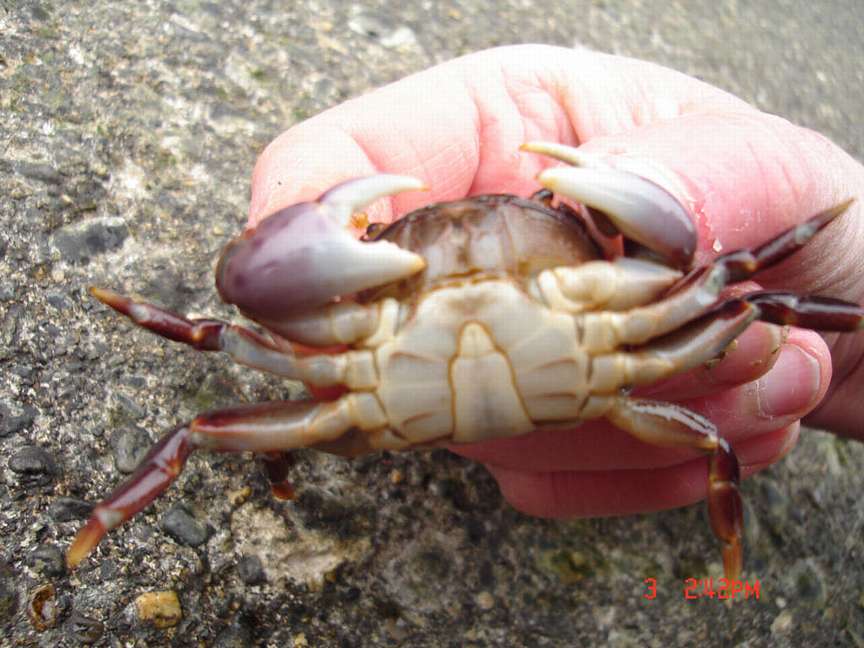Parastichopus californicus escapes predation by the sunflower seastar Pycnopodia helianthoides. By releasing itself on the approach of the seastar the Parastichopus can be carried away by the current. Also shown are the escape responses of sea urchins and topshells.
Category Archives: Archived Video
California Sea cucumber reproduction
This California Sea Cucumber male was emitting sperm while in the tank at Race Rocks in early June, 2004 . This went on for several hours. Millions of sperm are broadcast into the water where they may have a chance encounter with eggs, also released into the current by the females. Of the great numbers of eggs and sperm released only a few are fertilized and actually make it to maturity. This is a good example of
r-selection in the population.
Johan Ashuvud Project at Race Rocks -2004
During the Johan Ashuvud project 2004, students explored the intertidal with Garry Fletcher. They examined various organisms as well as the artificial tidepool. In this video, we also get a chance to meet all the students taking part in the project.
A school visit by Journey middle school students
The Johan Ashuvud Project June 2004
On 1st June 2004, during the Johan Ashuvud project, we had Dr Gitai Yahel and Russel Wyeth explain to the students and faculty from Journey Middle School in Sooke their research at Race Rocks . This was during a live webcast by Emmanuel (PC 30) from Ghana and Paul (PC 30) from Nigeria. Later we showed the students various living organisms in the tank room and gave the students a tour of the island.
Journey Middle School students visit Race Rocks
On 1st June 2004, during the Johan Ashuvud project we had Dr. Gitai Yahel and Russel Wyeth explain to the students and faculty from Journey Middle School in Sooke their research at Race Rocks . This was during a live webcast by Emmanuel (PC 30) from Ghana and Paul (PC 30) from Nigeria. Later we showed the students various living organisms in the tank room and gave the students a tour of the island. In those years, Pearson College students were part of the Schools Project whereby many schools in the Sooke School District would send their grade seven class on a field trip at the invitation of the Pearson College Diving Service.
Variables Affecting Tidepools at Race Rocks
n the high intertidal areas of Race Rocks, there are tidepools with wide fluctuations of abiotic factors. The organisms inhabiting these pools are well adapted to these extremes. Garry talks to a biology class about some of the variables influencing these high tide pools, and the flagellated green algae living within them.
Gammarus sp. : Scud–The Race Rocks taxonomy
| Scientific classification | |
|---|---|
| Kingdom: | Animalia |
| Phylum: | Arthropoda |
| Subphylum: | Crustacea |
| Class: | Malacostraca |
| Order: | Amphipoda |
| Suborder: | Senticaudata |
| Family: | Gammaridae |
| Genus: | Gammarus Fabricius, 1775 |
| Type species | |
| Gammarus pulex Linnaeus, 1758 [1] |
 The Race Rocks taxonomy is a collaborative venture originally started with the Biology and Environmental Systems students of Lester Pearson College UWC. It now also has contributions added by Faculty, Staff, Volunteers and Observers on the remote control webcams. The Race Rocks taxonomy is a collaborative venture originally started with the Biology and Environmental Systems students of Lester Pearson College UWC. It now also has contributions added by Faculty, Staff, Volunteers and Observers on the remote control webcams. |
First Nations Divers at Race Rocks
November 2, 2003 : We hosted a group of divers from the Nass River area on a dive at Race Rocks. Accompanying the Divers were Matt Hill and his wife Joanne. Matt who comes from Dolphin Island near Prince Rupert, provided some interesting information about the interactions of the people of his nation with marine resources.

In Situ Measurement of Benthic Community Trophic Dynamics at Race Rocks
Research of GITAI YAHEL
In March, 2004, Dr.Gitai Yahel, a Post Doctorate researcher from the Biology Department at the University of Victoria, joined us for two dives at Race Rocks to check out the possibility of doing research there. He is interested in suspension feeders’ nutritional ecology and the role of dissolved substance as a food source for marine organisms. Currently he is trying to establish a field survey of the dissolved and picoplanktonic diet composition of active suspension feeders such as sponge, mussels and tunicates.
Sponges, bivalves and tunicates play an important role in the trophic dynamics of many benthic communities. However, direct in situ measurements of their diet composition, filtration and excretion rates are lacking. Our knowledge of these rates is based mostly on indirect, in vitro measurements. Recently we have developed an in situ, non-intrusive technique to directly measure the rate and efficiency by which an active suspension feeder removes (or discharges) substances from (to) the water it filters. The technique, termed “InEx”, is based on the simultaneous, pair-wise collection of the water Inhaled and Exhaled by the animal. The difference in the concentrations of a substance among a pair of samples provides a measure of the retention (or excretion) of the substance by the animal. Calculations of feeding (or excretion) rates are obtained by multiplying the concentration difference by pumping rate. The latter is concurrently measured by recording the movement of a dye front in a transparent tube positioned within the ex-current jet. An important quality of the InEx technique is the lack of any manipulation of the studied organisms thus allowing realistic estimates of the organism’s performance under natural conditions. Former work in tropical water had revealed novel aspects of suspension feeders’ nutritional ecology including the major role dissolved organic substances play in the diet of some reef sponges (Yahel et al. 2003, Limnology and Oceanography, 48, 141).
For the proposed work at Race Rocks we can foresee two phases:
I. Identifying target suspension feeding taxa
We will execute a field survey of common suspension feeders at Race Rocks. Targets groups include bivalves, ascidians, and sponges. SCUBA divers will sample the water inhaled and exhaled by the surveyed organisms to compare concentration changes of CDOM, DOC, bacteria, phytoplankton, other organic particles, plant nutrients, silica, and sediment grains. Sampling methods will include an Inherent Optical Properties sensor (IOP, providing both CDOM spectra, concentration and optical characterization of the particulate field), Laser In Situ Scattering instrument (LISST, providing measurements of particles concentration and size distribution), and discrete water samples (InEx). The discrete water samples will be analyzed using a high temperature total carbon analyzer, flow injection nutrient analyzer, and a flow cytometer. This sampling scheme will provide ‘snapshot’ information on the performance of individual organisms.
II. Continuous monitoring of individual ‘model’ organisms.
Longer term (hours to days) monitoring of organisms will provide a record of feeding and metabolic performance with respect to environmental parameters (e.g., current, light, ambient particles concentration, etc.). Our knowledge of such processes in the field is limited. Nevertheless, the few existing studies suggest that suspension feeder activity may undergo considerable diel shifts. Moreover, environmental variables such as food and sediment concentration are known to affect suspension feeder filtration rates. Multi-day instrumentation of individual suspension feeders will provide a continuous record of the material fluxes mediated by the animals. Two 16 MHz ADVs’ (Acoustical Doppler Velocimeters) will provide high frequency (~2 Hz) current and acoustical backscatter data. One ADV will sample the exhalant jet of the study animal while the other will sample the inhalant (ambient) water. Similarly, paired measurements of optical water properties will be obtained by slowly pumping small amounts waters through a 4 sensor array mounted on a nearby frame. The instrument array will include: LISST-100, IOP sensors (WetLabs ac-9, and Eco-VSF,) CTD, and a Seabird oxygen sensor. The latter will allow us to estimate respiration rate and to correlate it to measured material fluxes mediated by the studied organisms. An online video camera equipped with an infra-red light source will be used to monitor the immediate vicinity of the exhalant aperture to allow better interpretation of behavior related signals (e.g. the presence of predators or sediment resuspension events).
Target organisms will be carefully selected based on the results of the survey in phase I. A priori, plausible candidates for these experiments are sponges and large bivalves (e.g. Mytilus californicus). These animals possess a large ex-current aperture that allows easy instrumentation and previous studies suggest that they may be capable of removing large quantities of DOC from the water.
Note that the proposed work in absolutely non destructive and the studied animals will not be manipulated by any means.
SEE ALSO https://www.racerocks.ca/journey-middle-school-students-visit-race-rocks/
~~~~~~~~~~~~~~~~~~~~~~~~~~~~~~~~~~~~~~~~~~~~~~~~~
Hemigrapsus nudus-Purple Shore Crab– The Race Rocks Taxonomy
- Dorsal view of the purpleshorecrab
- Ventral view – male purple shore crab
At the mid-intertidal rocky shore level on southern Vancouver Island, you will frequently find this as the most common species of shorecrab. At Race Rocks, they particularly like the loose rock habitat of the intertidal area beside the boat ramp on the jetty. The maximum size this crab attains is that shown in the video, about a 2cm. width of carapace. Thanks to Taarini Chopra and the environmental systems class for this video done as part of a study on biotic associations of the invertebrates at Race Rocks. This species is a particularly good example because of the parasites it often carries
Domain Eukarya
Kingdom Animalia
Phylum Arthropoda
Class Malacostraca
Order Decapoda
Suborder Pleocymata
Family Grapsidae
Genus Hemigrapsus
Species nudus
Common Name: Purple shore crab
| Other Members of the Phylum Arthropoda at Race Rocks |
 The Race Rocks taxonomy is a collaborative venture originally started with the Biology and Environmental Systems students of Lester Pearson College UWC. It now also has contributions added by Faculty, Staff, Volunteers and Observers on the remote control webcams. The Race Rocks taxonomy is a collaborative venture originally started with the Biology and Environmental Systems students of Lester Pearson College UWC. It now also has contributions added by Faculty, Staff, Volunteers and Observers on the remote control webcams.
March October 2003- Taarini Chopra (PC yr 27) |


